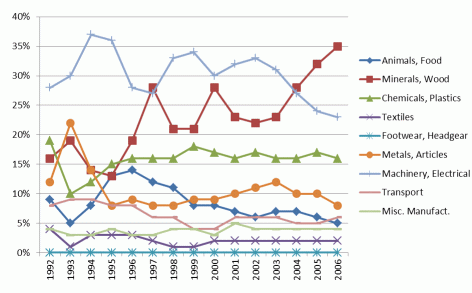| Author Name | THORBECKE, Willem (Senior Fellow, RIETI)/SMITH, Gordon (Anderson College) |
|---|---|
| Research Project | East Asian Production Networks and Global Imbalances |
| Download / Links |
This Non Technical Summary does not constitute part of the above-captioned Discussion Paper but has been prepared for the purpose of providing a bold outline of the paper, based on findings from the analysis for the paper and focusing primarily on their implications for policy. For details of the analysis, read the captioned Discussion Paper. Views expressed in this Non Technical Summary are solely those of the individual author(s), and do not necessarily represent the views of the Research Institute of Economy, Trade and Industry (RIETI).
International Macroeconomics Program (FY2011-FY2015)
East Asian Production Network and Global Imbalances Project
Many of China's imports are used to produce goods for re-export. This can be seen by looking at the two major categories of China's imports--imports for processing and ordinary imports. Imports for processing are used exclusively to produce goods for re-export. Ordinary imports are presented in Figure 1. The figure shows that 35 percent of ordinary imports were mineral and wood products and stone and glass, 25 percent were machinery and electrical products, and 15 percent were chemicals and related products, plastics and rubbers. These data suggest that the lion's share of China's ordinary imports consists of inputs into the production process rather than consumer goods.
The fact that so many of China's imports are used to produce goods for re-export makes it hard to estimate the responsiveness of imports to exchange rate changes. An appreciation of the renminbi (RMB) that reduces exports will also reduce imports that are used to produce goods for re-export. Thus, even though a stronger RMB increases the purchasing power of domestic agents and thus their ability to import, this effect may not show up in the data because a stronger RMB reduces exports and thus imports that are used to produce exports.
Figure 1
Ordinary Imports by Industry (Percent of Total Value)

To circumvent this problem, we control for re-exports when estimating the effect of exchange rate changes on China's imports. The results indicate that there is a close link between imports and exports. They also show that a 10 percent RMB appreciation would increase imports for processing and ordinary imports by three to four percent.
China has invested in heavy industries in recent years. Its supply chains have become deeper and its industrial clusters more involved in higher value added activities. This has increased the potential for import substitution between sophisticated goods produced in China and other supply chain countries. In addition, China's imports of consumption goods are increasing, especially from Europe. As these trends continue, the responsiveness of China's imports to exchange rate changes should increase. Thus, an appreciation of the RMB should help to raise China's imports and rebalance its economy. Chinese policymakers should take account of the fact that a stronger currency would benefit consumers and firms by allowing them to purchase more from abroad.

